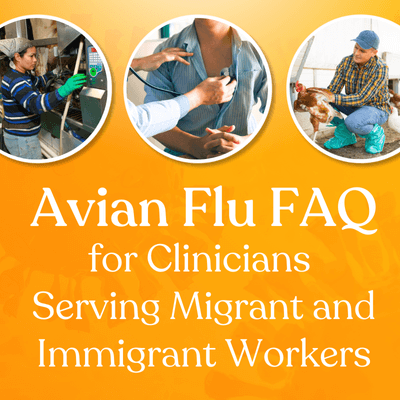Workplace Protections for Essential Workers Must Consider RIM Communities

[Editor’s note: Today’s blog post was originally published on the blog of the National Resource Center for Refugees, Immigrants, and Migrants (NRC-RIM). Click here to read the original post. Access “Navigating Occupational Health and Safety Regulations During Public Health Emergencies,” a checklist created jointly by Migrant Clinicians Network and NRC-RIM, in English and Spanish on NRC-RIM's website.]
While COVID-19 is a public health threat to the entire US population, there is growing evidence that the outbreak disproportionately affects some populations, including certain refugee, immigrant and migrant (RIM) communities.
RIM communities are disproportionately affected by COVID-19 not because of any biological or genetic factor, but because of long-standing, systemic, health and social inequities. It particularly affects people in these communities who work in essential jobs, like farmworkers and food processing plant employees.
Despite their challenges, refugees, immigrants, and migrants are an integral part of the nation’s social, cultural, and economic vitality. They have proven that they are strong, resilient and dedicated to the success of the communities where they live during this unprecedented time. With the right tools, we can eliminate the health disparities they face.
Workplace Safety Protections Are Crucial
One of the ways we can reduce these health disparities is by ensuring all workers, and in particular workers in essential jobs, have workplace safety protections. The implementation of safety protocols not only reduces community transmission, but is it also legally required to protect workers on the job. However, many workplaces are not prepared to design and implement the measures needed to protect workers, as they do not have staff with specialization or training in occupational health and safety.
The Migrant Clinicians Network, in partnership with NRC-RIM, developed a checklist with the basic components of occupational health and safety regulations that are important to consider during the COVID-19 pandemic. Highlights include:
- • Create a written protocol and training for employees on COVID-19 prevention efforts• Analyze the various tasks of a given job and the risk of COVID-19 transmission of each. Use this information to design prevention and control efforts.• Train employees on how to use available disinfectant safely, and provide protective equipment as needed so they can use these chemicals safely.• Provide employees with hand, eye and respiratory protection as appropriate for their jobs.• Ensure training is culturally and linguistically appropriate, and ensure there is adequate communication so employees can ask questions and request clarification.Create a written protocol and training for employees on COVID-19 prevention efforts.
- Analyze the various tasks of a given job and the risk of COVID-19 transmission of each. Use this information to design prevention and control efforts.
- Train employees on how to use available disinfectant safely, and provide protective equipment as needed so they can use these chemicals safely.
- Provide employees with hand, eye and respiratory protection as appropriate for their jobs.
- Ensure training is culturally and linguistically appropriate, and ensure there is adequate communication so employees can ask questions and request clarification.
For more information, download the checklist in English and Spanish.
Got some good news to share? Contact us on our social media pages above.
Return to the main blog page or sign up for blog updates here.
- Log in to post comments





